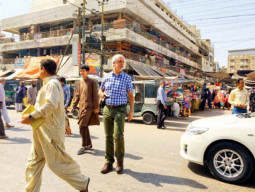
The Institute for Transportation and Development Policy (ITDP) was commissioned by The Asian Development Bank (ADB) to develop a conceptual design for the Bus Rapid Transit (BRT) Corridor in Karachi. The work began in September 2014 and finished in March 2015. It was presented to stakeholders, including the government of Sindh, Karachi Mass Transit Cell, NGOs and Karachi transporters on March 20.
The red BRT corridor is 25 kilometres long with 41 stations — stretching from Safoora Roundabout along the University Road and continues to MA Jinnah Road until Merewether Clock Tower.
The proposal would cost Rs10.4 billion, or an average of Rs402 million per kilometre. In comparison to that of Lahore BRT’s which came to an average of Rs1.3 billion per kilometre, triple the cost of the proposed red line BRT in Karachi.

Red line BRT design is the first BRT design in Karachi (and possibly in Pakistan) that integrates with other public transport systems. The design considers the existing bus routes to be part of the BRT, called the “direct-service” BRT model. With this model, the existing bus routes will become the BRT routes, serving residential areas and other areas outside the BRT corridor. Although red line BRT corridor will only have one corridor, but the design proposed 23 BRT routes to be running, which will create wider expansion of the BRT, and make it into a high capacity BRT system.
Initially it proposed that the BRT on red line will run with the frequency of 150 buses per hour per direction, or one bus every 24 seconds, and after few years, the frequency will increase up to 220 buses per hour per direction (16 seconds between buses). The system will also require 1,600 new buses to be procured at the beginning, a significant difference with the Lahore BRT, with only 64 buses for the entire system. It is also estimated that the red line BRT corridor will cater to more than 625,000 passengers every day in the beginning which is five times more than what the Lahore BRT caters. If the red line is implemented, it will be of the highest capacity in Pakistan and South Asia and the second highest capacity BRT in Asia, after Guangzhou, China.
Red line BRT will also be constructed entirely at-grade, as this will trigger urban development along the corridor, similar to what happened in other BRT systems around the world. Construction of an elevated BRT should be avoided and prohibited in Karachi as an elevated BRT will create the following problems: the system will become non-flexible for future corridor developments. It will destroy the urban development along the corridor. As shown by Lahore BRT, for buses to enter in the middle of the corridor without ramps the operation will be inefficient as the buses have to travel from the beginning of the corridor to reach the stations in the middle.
The distance between the stations can be very far and may discourage passengers from using the BRT. In the case of Karachi, building the elevated BRT at MA Jinnah Road near tower will destroy the area and the possibility for urban regeneration. Any plan that suggests an elevated BRT at MA Jinnah needs to be stopped and scrapped immediately.
It is very unfortunate that the government of Sindh has decided to go on its own and has rejected to continue to work with the ADB assisted by ITDP, as these two organisations have developed and implemented many successful BRT systems around the world. Missing the opportunity to work with top leading organisations in BRT development could lead the BRT project in Karachi in the wrong direction and destroy the entire public transport condition in Karachi.
Published in The Express Tribune, March 27th, 2015.
Like Opinion & Editorial on Facebook, follow @ETOpEd on Twitter to receive all updates on all our daily pieces.




























































COMMENTS (3)
Comments are moderated and generally will be posted if they are on-topic and not abusive.
For more information, please see our Comments FAQ